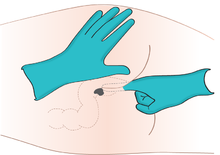Rectal administration


Glycerin (laxative
) suppositories for insertion into the rectum.

Rectal administration (colloquially known as boofing or plugging) uses the
bodily systems.[Note 2]
A drug that is administered rectally will in general (depending on the drug) have a faster onset, higher
catheter
.
The rectal route of administration is useful for patients with any digestive tract motility problem, such as
subcutaneous
medication delivery in other instances.
Methods
Rectal administration of medication may be performed with any of the following:
- A suppository, a solid drug delivery system inserted into the rectum, where it dissolves or melts to exert local or systemic effects.
- A micro-enema, a small amount (usually less than 10 millilitres) of a liquid-drug solution injected into the rectum.
- A large volume enema[6] to inject liquid into the colon either to cleanse feces from as much of the colon as possible[7] or to deliver a drug solution.
- A specialized catheterdesigned for rectal administration of medications and liquids, that can be placed safely and remain comfortably in the rectum for repeated use.
See also
Wikimedia Commons has media related to Rectal administration.
Notes
- first-pass metabolismthrough systemic distribution and the rest is taken through the liver and metabolized via the hepatic portal system .
- cardiovascular system(CVS), et cetera.
- intravenous injection (IV), insufflation ("snorting"), et cetera, but the oralroute does not bypass first-pass metabolism.
References
- ^ De Boer AG, Moolenaar F, de Leede LG, Breimer DD. (1982) "Rectal drug administration: clinical pharmacokinetic considerations." Clin Pharmacokinetics. 7(4):285–311
- ^ Moolenaar F, Koning B, Huizinga T. (1979) "Biopharmaceutics of rectal administration of drugs in man. Absorption rate and bioavailability of phenobarbital and its sodium salt from rectal dosage forms." International Journal of Pharmacaceutics, 4:99–109
- ^ Plumer AL. 2007. Plumer's Principles and Practices of Intravenous Therapy. Lippincott Williams & Wilkins. 753 pp.
- ^ "National Hospice and Palliative Care Organization's Facts and Figures: Hospice Care in America, 2013 Edition" (PDF) Archived 2014-05-13 at the Wayback Machine
- ^ A Quality Improvement Study: Use of a Rectal Medication Administration Device Intervention to manage end-stage symptoms in hospice patients when the oral route fails. Poster Presentations. 6th Annual Hospice Palliative Nurses Association Clinical Practice Forum, Pittsburgh, PA, September 15-15, 2012
- ^ "high enema". Medical Dictionary. Merriam-Webster. Retrieved 2021-04-18.
- ^ Rhodora Cruz. "Types of Enemas". Fundamentals of Nursing Practice. Professional Education, Testing and Certification Organization International. Retrieved 2021-04-18.





